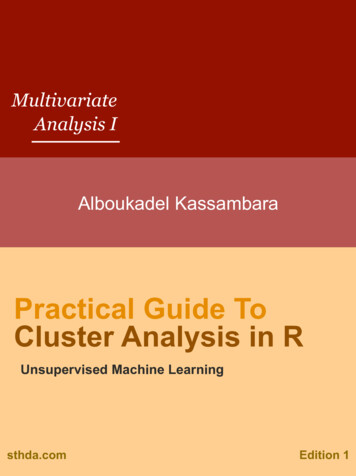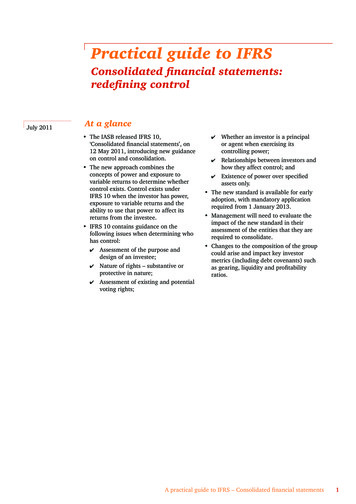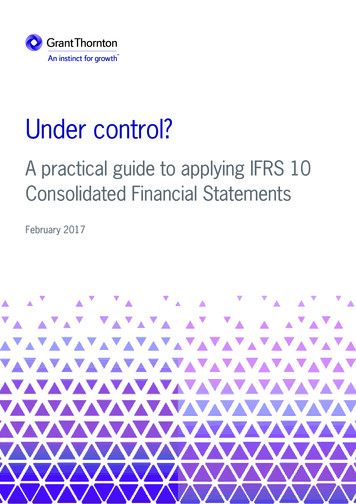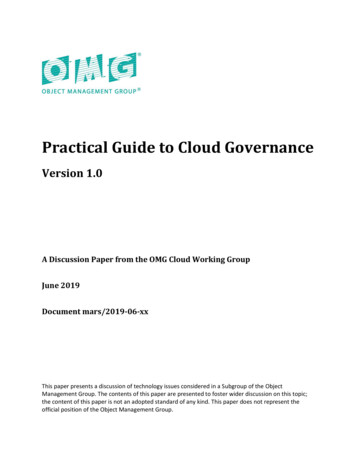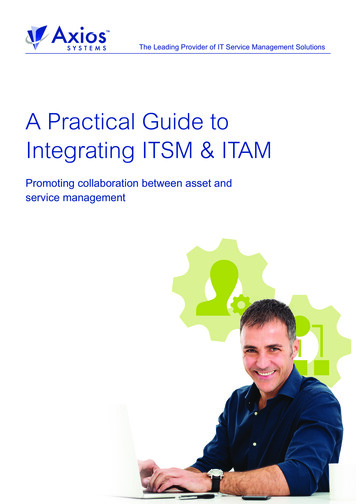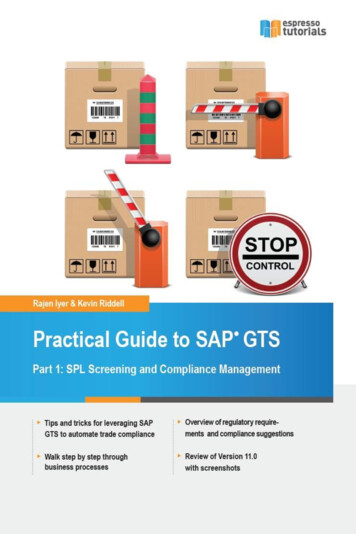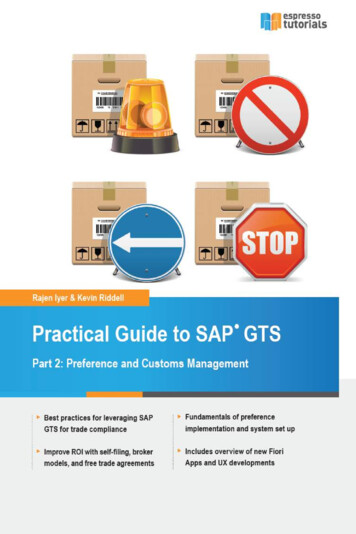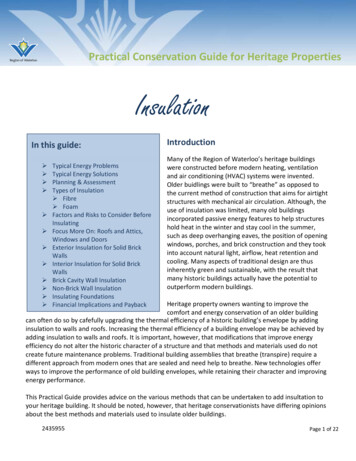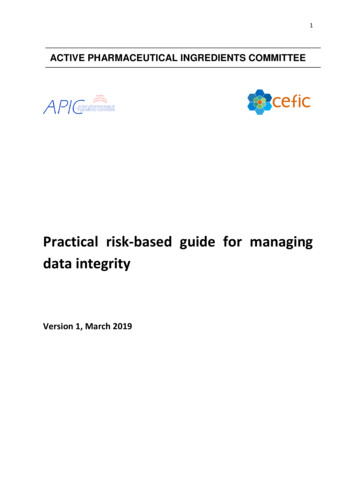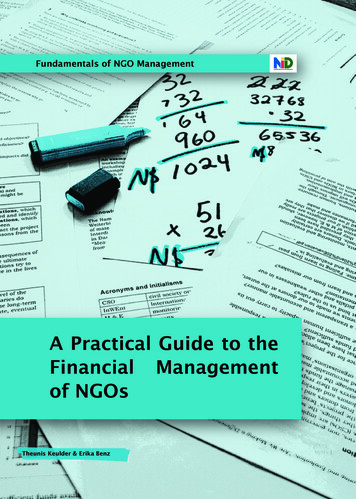
Transcription
Fundamentals of NGO ManagementFundamentals of NGO ManagementA Practical Guide to theFinancial Managementof NGOsTheunis Keulder & Erika Benz1
Fundamentals of NGO ManagementA Practical Guide to the FinancialManagement of NGOsTheunis Keulder & Erika BenzPublished byNamibia Institute for DemocracyFunded byUnited States Agency for International Development (USAID) and the Embassy of FinlandCopyright: 2011, Namibia Institute for DemocracyNo part of this book may be reproduced in any form or by any means, electronic ormechanical, including photocopying, recording, or by any information storage andretrieval system, without the permission of the publisher.Design and Layout: DV8 Saatchi & SaatchiPrinted by: John Meinert Printing, Windhoek, Namibia, 2011Language Editor: William Hofmeyr & Leonie Hofmeyr-JuritzISBN: 978-99916-865-3-0
Fundamentals of NGO ManagementForewordAs part of its programme to strengthen civil society in Namibia, the Namibia Institute forDemocracy (NID) has since 2005 conducted a wide range of training and technical assistanceprogrammes aimed at improving the internal management of civil society organisations. Thisguide, which is published as part of the NID’s Fundamentals of NGO Management series, has beendeveloped using inputs obtained from numerous training sessions with NGOs, and is intendedto assist organisations in their financial management function. It is also used extensively by theNID in training civil society organisations in financial management matters.The guide provides an introduction for the non-financial manager or leader to controllingthe finances of an organisation in such a way that the organisation can discharge its dutyof being financially accountable. It should be reviewed by everyone in an organisation whois responsible for financial management, including those who prepare grant proposals andthose who record and report on grant project activities. The guide is not offered as a completemanual of procedures on financial administration; it is intended only to provide practicalinformation on what is expected from organisations in terms of fiscal accountability. Tothis end, the most important financial reporting and administrative forms are annexed astemplates. A case study is also attached for practical training purposes.In this guide, the term Non-governmental Organisation (NGO) will be used collectively todescribe civil society organisations, community-based organisations, non-state actors, welfareorganisations, NGOs and any not-for-profit civic groups that have been formed to provide aparticular service. Although the main executive position in an NGO is commonly referred toas the Executive Director, Chief Executive Officer or Managing Director for example, in thisguide the term Executive Director will be used throughout for ease of reference. Similarly, thegoverning board will be referred to as the Board of Directors.Theunis KeulderExecutive DirectorNamibia Institute for Democracy
Fundamentals of NGO ManagementAcronyms and InitialismsNIDNamibia Institute for DemocracyNGONon-Governmental OrganisationPAYE Pay-As-You-EarnSSCSocial Security CommissionContentsForeword1Introduction to financial management2The accounting system2.1The funding agreement . 82.2The budget. 82.3Bank accounts . 102.4Petty cash . . 102.5Procurement. 112.6Recording of project activities. 122.7Payments. 132.8Bank transactions – cash book . 142.9Cash transactions – petty cash . 15.5. .82.10 Monthly summaries of expenses. 152.11 Trial balance . 152.12 Balance sheet and income statement . 152.13 Audited annual financial statements . 163Reporting to a donor4Staff administration4.1The employment agreement . . 194.2Salary payments . 204.3Income tax registration of the organisation . 204.4Income tax registration of employees . 214.5Social Security Commission . 214.6The Employee Compensation Act of 1941 . 214.7Administration of leave . 214.8Consultants . 22.19.19
Fundamentals of NGO ManagementAnnexures . 23Annex 1: Expense summary . 24Annex 2: Reconciliation of donor contribution . 26Annex 3: Fixed asset list . 28Annex 4: Purchase order. 30Annex 5: Attendance register: Grassroots seminars. 31Annex 6: Attendance register: Workshops . 32Annex 7: Travel claim form . 33Annex 8: Daily allowance claim form . 34Annex 9: Financial report: Workshop . 35Annex 10: Confirmation of goods purchased . 36Annex 11: E-bank requisition . 37Annex 12: Cheque requisition. 38Annex 13: Petty cash requisition. 39Annex 14: Petty cash summary . . 40Annex 15: Trial balance . 41Annex 16: Cash book. 42Annex 17: Payslip . 44Annex 18: Leave application . 45Annex 19: Record of leave . 46Annex 20: Honoraria agreement . 48Annex 21: Case study . 49Bibliography. 68
Fundamentals of NGO Management1 Introduction to financial managementLeaders and managers of NGOs have to develop, at the very least, basic skills in financialmanagement. Expecting others in the organisation to manage finances is clearly asking fortrouble. Basic skills in financial management start in the critical areas of cash managementand bookkeeping, which should be carried out following certain financial controls to ensureintegrity in the bookkeeping process. New leaders and managers should swiftly learn how togenerate financial statements (from bookkeeping journals) and analyse those statements soas to develop a real understanding of the financial condition of the organisation. Financialanalysis shows the ‘reality’ of the situation of an organisation – and as such, is one of themost important practices in management. This guide will provide you with an understandingof common practice in financial management, and help you to build the basic systems andpractices needed in a healthy organisation.The financial situation of an organisation should be reviewed at least on a monthly basis, withthe focus on the budget, receipts of income and expenditure. The Executive Director/financialofficer shall be responsible for ensuring that financial controls are in place and adhered toand, more specifically, that: expenditures remain within the budget, expenditures are only for the purposes set out in the budget, financial documentation, including quotations, invoices and receipts are collectedand filed in an or
manual of procedures on financial administration; it is intended only to provide practical information on what is expected from organisations in terms of fiscal accountability. To this end, the most important financial reporting and administrative forms are annexed as templates. A case study is also attached for practical training purposes.File Size: 1MBPage Count: 76

